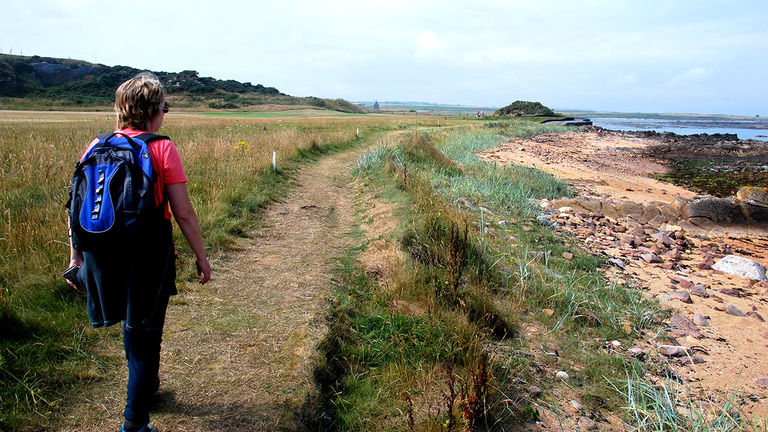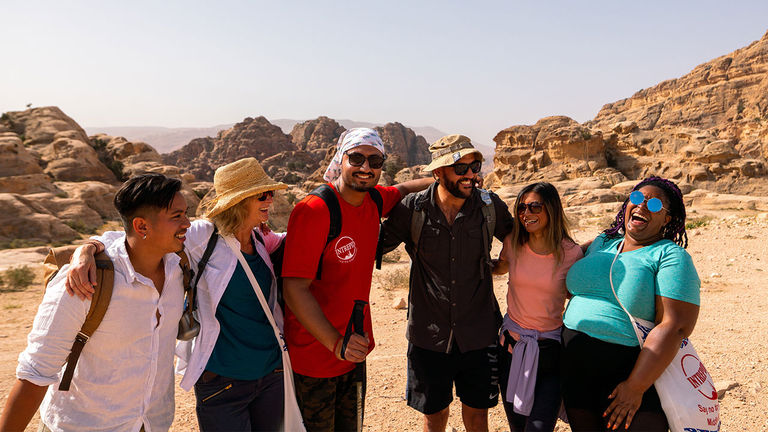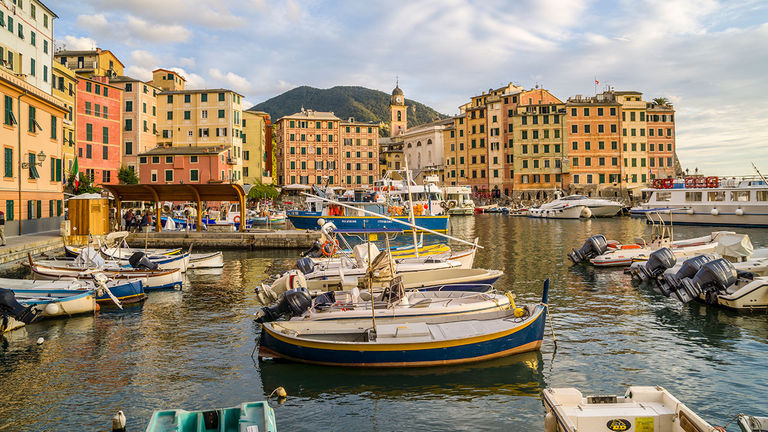Long before there were packaged tours and organized travel experiences, humans traversed the land on foot: They led grazing livestock through valleys and over mountain passes, followed in the footsteps of wildlife and journeyed along pilgrimage routes to sacred sites.
Walking has been part of the human experience for millennia, and it’s not a new vacation activity. In fact, walking holidays have long been popular in Europe, especially in the United Kingdom, where some walking-specific tour companies have been in operation for decades. For many American travelers, however, the concept is still a bit foreign. But a perfect storm of circumstances both in and beyond the tourism industry over the past few years has led to a global explosion of walking-centered travel experiences — a slow travel trend that shows no signs of slowing down.
Why We’re Walking More
In 2019, tourism was experiencing accelerated growth. even as the climate crisis affected all aspects of the travel industry. But it was the COVID-19 pandemic and the resulting global lockdown that kicked the walking holiday into a higher gear.
 The Fife region of Scotland is a popular choice for a multiday coastal walking holiday.
The Fife region of Scotland is a popular choice for a multiday coastal walking holiday.
Credit: 2022 InntravelIsolated from others and cooped up in their homes, people were eager to get outside into wide-open (and socially distant) spaces. According to data collected by Natural England’s People and Nature Survey, the number of people spending time outside has increased from 49% in March 2021 to 61% in February 2022. Furthermore, 41% of people from this recent survey said visiting green and natural spaces has become even more important to their well-being since pandemic restrictions began.
With international travel out of the picture and many activity vendors temporarily closed, the pathways created generations ago literally laid the groundwork for the trails people sought out for their pandemic vacations. And, it just so happened that these walking holidays also ticked many other boxes for travelers: They were environmentally friendly, allowed people to escape confinement for less crowded and quiet environments, introduced them to off-the-beaten-path destinations and had huge health benefits.
Walking and good mental health go hand in hand, and over the last couple of years, more people have taken up walking and being in the outdoors to combat other stresses.
“Walking and good mental health go hand in hand, and over the last couple of years, more people have taken up walking and being in the outdoors to combat other stresses,” said Tali Emdin, manager of Walkers’ Britain, which has seen a recent surge of interest from travelers. “This is particularly the case in long-distance walking where people get the itch to complete these trails, such as walking coast to coast [in England] or along the spine of the Pennines. We are also seeing demand for those wanting to tick off the National Trails [of the U.K.]."
Now, borders are opening and travel is picking up again, but the traveler mindset seems to have shifted over the past couple of years, leading many companies to add walking holidays to their product line — or increase their portfolio of those they already offer.
 A guided walk in Jordan with Intrepid Travel
A guided walk in Jordan with Intrepid Travel
Credit: 2022 Intrepid TravelIntrepid Travel, for example, added 15 new guided walking itineraries this year, including a five-day walk in California’s Sierra Nevada mountains.
“A majority of global travelers (87%) say that they want to travel more sustainably,” said Matt Berna, president of Intrepid Travel North America. “After being stuck inside for two years due to COVID-19, travelers want to be outside, challenge themselves physically and explore all that the world has to offer in nature, not stay around busy cities.”
What, Exactly, Is a Guided Walking Trip?
Surely, we all know what it means to walk, but what is less clear is how a walking holiday differs from trekking or hiking trips. “Trekking” generally refers to particularly strenuous, often remote, backcountry expeditions, such as those to Everest Base Camp in Nepal and other mountainous regions. A bit hazier is the distinction between “hiking” and “walking.”
“In Europe, walking is often used as terminology for hiking, and Europe’s landscapes, while still very impressive, tend to be on a scale that means exploring them is less of an undertaking — think laid-back adventure rather than demanding expedition,” said Simon Wrench, head of marketing at tour operator Inntravel.
 Inntravel has several walks that take walkers through charming Italian towns.
Inntravel has several walks that take walkers through charming Italian towns.
Credit: 2022 InntravelThe company has added several new walks this year, including a self-guided walk in Western Sicily; a walk in Snowdonia, a new UNESCO World Heritage Site in Wales; and a 10-night journey along the “Old Way” on the Portuguese Camino, which offers an alternative to the popular Camino Frances in northern Spain.
One of the key features of a walking holiday isn’t about the walk itself, but the towns and villages through which walkers pass and spend the night. Trekking and hiking are often affiliated with camping and “roughing it” in the backcountry.
On a walking holiday, you might be walking in the wilderness all day long, but in the evening, you come back to a local inn, you meet the innkeepers, you meet the other people who are there, and you hang out with people at the pub or restaurant.
Walking holidays, in contrast, emphasize the slow travel ethos of meeting local people in cafes and pubs, supporting small businesses and staying in unique accommodations.
“The distances between villages — or, more importantly, comfortable places to stay — are such that hiking or walking from hotel to hotel can be a leisurely, relaxed affair, although there can be more physically demanding routes for those who enjoy a challenge, too,” Wrench said.
“On a walking holiday, you might be walking in the wilderness all day long, but in the evening, you come back to a local inn, you meet the innkeepers, you meet the other people who are there, and you hang out with people at the pub or restaurant,” said Clare Coleman, creator of Trips to WalkAbout, a database of do-it-yourself trail information and tour companies offering self-guided walking trips. “It’s the best kind of experience: You have that time to get away, which is what people want when they go on vacation sometimes, but you’re still experiencing the place that you’re visiting, as well.”
Variations on a Walking Tour
Not only is a walking vacation different from a trekking trip, but there are also different types of walking holidays that advisors could book for travelers: either guided or self-guided, and inn-to-inn or center-based.
Guided walks are led by a leader and may be with small groups or booked privately. As with most guided experiences, meals, lodging and transportation are provided. Conversely, self-guided walking is for travelers who want to explore on their own and at their own pace. Companies offering self-guided tours provide travelers with detailed route maps and notes, lodging, some meals (often breakfast) and luggage transport between accommodations.
 Most guided walking experiences include lodging, meals and transportation.
Most guided walking experiences include lodging, meals and transportation.
Credit: 2022 Intrepid TravelWhile the walking holiday concept is still in its infancy in the U.S., the movement is largely driven by people who are familiar with inn-to-inn walking in Europe. On these multi-day routes, travelers spend their days walking from one accommodation to another. The journey might be linear, starting in one place and ending in another, or it might be circular, which means that after several inn-to-inn walking days, travelers end up where they started on the first day. Depending on trail conditions and availability, companies booking both guided and self-guided trips may offer pick-up services so that clients are not forced to walk in dangerous or unattractive areas, such as along roads.
There are also center-based walks, such as the climate-conscious walks in Sri Lanka offered by Ayu in the Wild. These are multi-day experiences with daily walks that begin and end at the same accommodation each day. This eliminates the need for luggage transfers between accommodations, either by vehicle or the walkers themselves. Ayu in the Wild’s walks are designed for travelers to immerse themselves in a specific place, get to know the biodiversity of the region, meet people and taste the regional cuisine, said Chamintha Jayasinghe, co-founder of the company.
Walking holidays vary in length (both number of days and per-day distance), terrain and difficulty, and the variety of walking holidays means there’s likely something for any interested traveler. They are also particularly versatile and ideal for adding onto or combining with other trips.
How to Walk the Talk With Prospective Clients
While the U.S. is home to long-distance hiking trails such as the Pacific Crest Trail and Appalachian Trail, there are few inn-to-inn walks in the country. As such, many Americans are still unfamiliar with the concept of walking holidays, but Wrench said the tides seem to be shifting.
Every time I have a conversation with someone and I tell them that this exists, they light up. They say, "Wow, why have I never heard of this?"
“As a company based in the U.K., Inntravel naturally caters to U.K. customers,” he said. “But, in 2019, prior to COVID-19, the company had seen interest increase from overseas to the extent that 20% of its walking holiday customers came from North America. While this share has halved since COVID-19, interest from the North American market is showing signs of picking up strongly and especially in getting plans in place for 2023.”
Tour operators note that when agents discuss these experiences with their clients, they need to be very mindful of their clients’ physical capabilities. Ask about their walking and hiking experience, get a feel for the kind of terrain and difficulty level they are interested in, and ask about how much time they want to spend walking each day.
“Recommending the right itinerary to clients is key,” Intrepid’s Berna said. “Making sure customers are a fit for a given trip will allow them the right balance of challenge and enjoyment.”
And, even though walking may not be as strenuous as hiking or trekking, it can still be demanding, so clients might need to train leading up to the start of a trip. The great outdoors can be temperamental, and advice for packing proper clothing and correct footwear is also essential.
With this in mind, all signs point toward opportunity: As operators continue to develop new walking trips and awareness grows among Americans, in particular, the time is ripe for agents to include walking holidays in their portfolios.
“As Americans, we like that form of travel, we just don’t know about it,” said Coleman of Trips to WalkAbout. “Every time I have a conversation with someone and I tell them that this exists, they light up. They say, ‘Wow, why have I never heard of this?’”